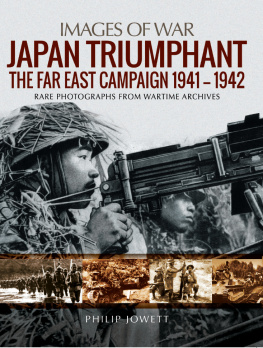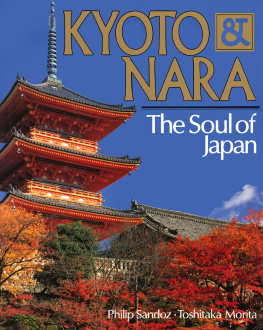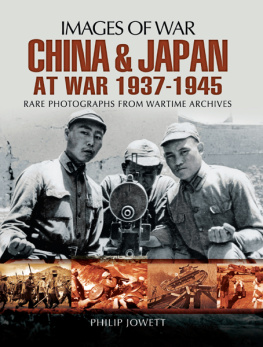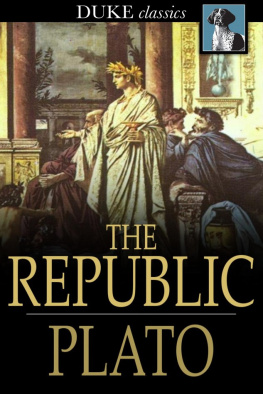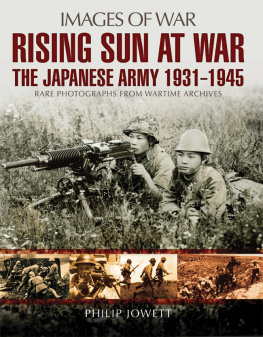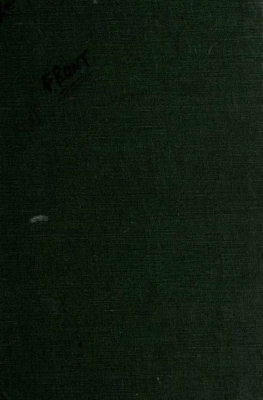Philip Jowett - Japan Triumphant
Here you can read online Philip Jowett - Japan Triumphant full text of the book (entire story) in english for free. Download pdf and epub, get meaning, cover and reviews about this ebook. publisher: Pen and Sword Military, genre: Non-fiction. Description of the work, (preface) as well as reviews are available. Best literature library LitArk.com created for fans of good reading and offers a wide selection of genres:
Romance novel
Science fiction
Adventure
Detective
Science
History
Home and family
Prose
Art
Politics
Computer
Non-fiction
Religion
Business
Children
Humor
Choose a favorite category and find really read worthwhile books. Enjoy immersion in the world of imagination, feel the emotions of the characters or learn something new for yourself, make an fascinating discovery.
- Book:Japan Triumphant
- Author:
- Publisher:Pen and Sword Military
- Genre:
- Rating:3 / 5
- Favourites:Add to favourites
- Your mark:
- 60
- 1
- 2
- 3
- 4
- 5
Japan Triumphant: summary, description and annotation
We offer to read an annotation, description, summary or preface (depends on what the author of the book "Japan Triumphant" wrote himself). If you haven't found the necessary information about the book — write in the comments, we will try to find it.
Japan Triumphant — read online for free the complete book (whole text) full work
Below is the text of the book, divided by pages. System saving the place of the last page read, allows you to conveniently read the book "Japan Triumphant" online for free, without having to search again every time where you left off. Put a bookmark, and you can go to the page where you finished reading at any time.
Font size:
Interval:
Bookmark:

IMAGES OF WAR
JAPAN TRIUMPHANT
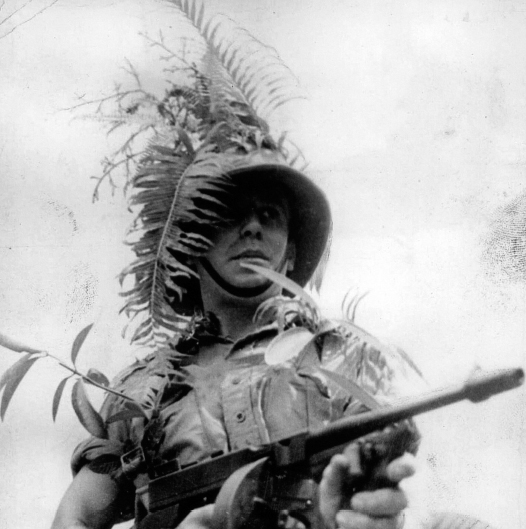
This Thompson sub-machine-gunner of the Manchester Regiment is on jungle exercises in Malaya in the months leading up to war with Japan. Any jungle training undertaken by the British and Australians in 1941 did not prepare them when encountering the superior field skills of the Japanese Imperial Army. Perhaps the foliage attached to his rather ungainly cork sun helmet as camouflage is symbolic of the difference between the two combatants. It sums up the lack of understanding on the part of the British command of what kind of enemy they were to face a few months later.
IMAGES OF WAR
The Far East Campaign
19411942
RARE PHOTOGRAPHS FROM WARTIME ARCHIVES
Philip Jowett

This book is dedicated to my inspiring mother, June, and to her much-loved father, Gunner John Smith-Pounder, who served in the 12th Battery, 6th Heavy Anti-Aircraft Regiment, Royal Artillery in Singapore in 1941. He, like most of his fellow artillerymen, was transferred to Java and fought as an infantryman during the fall of the Netherlands East Indies. Taken prisoner, he died in Pakan Baroe Japanese Prisoner of War Camp on Sumatra on 9 August 1945.
First published in Great Britain in 2019 by
PEN & SWORD MILITARY
an imprint of
Pen & Sword Books Ltd,
47 Church Street,
Barnsley, South Yorkshire, S70 2AS
Copyright Pen & Sword Books Limited, 2019
Every effort has been made to trace the copyright of all the photographs.
If there are unintentional omissions, please contact the publisher in writing, who will correct all subsequent editions.
ISBN 978 1 52673 435 8
eISBN 978 152673 436 5
Mobi ISBN 978 152673 437 2
The right of Philip Jowett to be identified as Author of this Work has been asserted by him in accordance with the Copyright, Designs and Patents Act 1988.
A CIP record for this book is available from the British Library.
All rights reserved. No part of this book may be reproduced or transmitted in any form or by any means, electronic or mechanical including photocopying, recording or by any information storage and retrieval system, without permission from the Publisher in writing.
Pen & Sword Books Ltd incorporates the imprints of Pen & Sword Aviation, Pen & Sword
Family History, Pen & Sword Maritime, Pen & Sword Military, Pen & Sword Discovery,
Wharncliffe Local History, Wharncliffe True Crime, Wharncliffe Transport, Pen and Sword
Select, Pen and Sword Military Classics, Leo Cooper, The Praetorian Press, Remember
When, Seaforth Publishing and Frontline Publishing and White Owl
For a complete list of Pen & Sword titles please contact
Pen & Sword Books Limited
47 Church Street, Barnsley, South Yorkshire, S70 2AS, England
E-mail:
Website: www.pen-and-sword.co.uk
D uring a six-month period between early December 1941 and May 1942 the Japanese Imperial Army, Navy and Air Force conquered most of South-East Asia and much of the Pacific. This lightning campaign was in reality a series of separate but inter-related campaigns which saw Japan gain huge territories. By May 1942 Japan had taken Malaya, Burma, Borneo, Hong Kong, the Philippines and the Netherlands East Indies. Japan also gained virtual control over French Indo-China and an alliance with the only independent South-East Asian country, Thailand. In addition, her conquests in the Pacific saw the occupation of any islands previously under British, US, Australian or Dutch rule. The carefully prepared campaign of conquest had been in the planning stages for many years and its success changed forever the political situation in the Far East. Although the peoples of South-East Asia were only effectively swapping one colonial master for another, they would not accept the return of their old masters post-1945.
After coming out of centuries of self-imposed isolation in the 1860s, Japan quickly showed that it had ambitions to create an empire for itself in Asia. From 1894 until 1941 the Japanese Imperial Army and Navy had concentrated on an aggressive Northern Road doctrine which called for their domination of mainland China, Manchuria and Korea. This led to the Sino-Japanese War of 18945, the Russo-Japanese War of 19045, the Intervention in Siberia in 191922 and the invasions of Manchuria in 1931 and the rest of China in 1937. Other military theorists in Japan had called for a Southern Road policy which would see the Japanese conquest of South-East Asia. This had the disadvantage of conflict with the Imperial Powers of Britain and the Dutch and in all probability the USA. From 1894 the Japanese had had a more or less free hand in mainland Asia defeating Imperial China, Imperial Russia and Nationalist China. Its invasion of Manchuria in 1931 and the rest of China in 1937 and the atrocities committed by the Imperial Army there led to widespread protests in the West. Whilst Europe was obsessed with the increasing threat of Nazi Germany, from 1933 the USA in particular focused on Japans aggression against China. Japan walked out of the League of Nations in 1933 in protest at criticism of its war in China and expected the European powers and the USA to mind their own business. Its chief politicians and military leaders had already hatched plans to first defeat China and then move south. This was the obvious conclusion of any switch from the Northern Road doctrine to the Southern Road doctrine. The term move south described the plan to invade the colonial possessions of Great Britain and the Netherlands in South-East Asia. These included British-ruled Burma, Malaya, Northern Borneo and the Royal Navy base on Singapore island on the southern tip of Malaya. The other main target for Japanese imperial expansion was the Netherlands East Indies which had vital oilfields that they coveted. Even though it was forecast that the oilfields in the Netherlands East Indies would run dry by 1944 they were still important to Japanese plans.
One thing that the Japanese wanted to avoid if at all possible was conflict with the USA as the US navy was seen as their potential main protagonist in the Pacific. The Japanese Imperial Navy may not have wanted a war with the USA but they had been planning for it anyway. If they did go to war the Philippines, which had been controlled by the USA since 1898, would then be added to the list of conquests. Growing public sympathy for Chinese people in the USA and in the more enlightened countries in Europe led eventually to the introduction of trade embargoes on Japan. To a country like Japan, which had little or no resources of its own apart from coal, its trade with the world was vital. Attempts to break these embargoes included, after 1940, putting pressure on the Dutch government in exile to allow peaceful access to their oil supplies. The stubborn refusal by the Dutch government in exile in London to give into Japanese pressure added another nail in the coffin of peace. After their mother country had been occupied by the Germans in May 1940, these exiled politicians were not in the mood to give into threats.
By October 1940 the Japanese had decided that the only way to gain the resources that its military machine badly needed was by conquest. In the USA the Roosevelt government imposed an Export Control Act on 5 July 1940. This severely affected Japanese trade and heavily damaged Japans industry as it could no longer import US goods. The USAs resolve to deal with Japan was further strengthened when the Japanese virtually took over French Indo-China in the summer of 1941. In July the USA froze all of Japans assets in their country under Executive Order 8832 which effectively stopped the Japanese from buying oil in the world markets. Now it was only a matter of when not if the Japanese would strike as 1941 turned into a bad year for the empire. In addition to their other problems, by 1941 the stalemate in China had become a major manpower drain for the Japanese Imperial Army. With no sign of total victory, the number of troops killed since 1937 stood at 189,000. Although the Chinese had suffered many times the number of casualties, there was no sign of the expected capitulation by Chiang Kai-sheks Nationalist government. It now became more urgent for the Japanese to get badly needed resources from the colonial possessions of the British and Dutch in South-East Asia. If the Japanese were to maintain their campaign on the Chinese mainland then they would now have to open a second front and Strike South.
Font size:
Interval:
Bookmark:
Similar books «Japan Triumphant»
Look at similar books to Japan Triumphant. We have selected literature similar in name and meaning in the hope of providing readers with more options to find new, interesting, not yet read works.
Discussion, reviews of the book Japan Triumphant and just readers' own opinions. Leave your comments, write what you think about the work, its meaning or the main characters. Specify what exactly you liked and what you didn't like, and why you think so.

